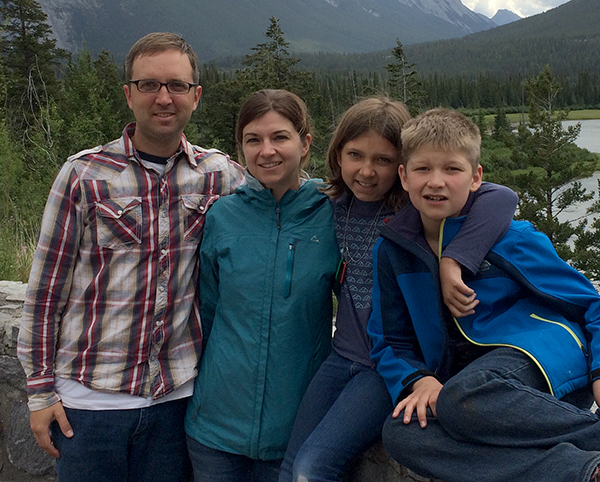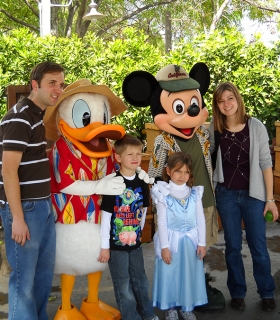Article at a Glance
At first, taking a family vacation with a child with autism can seem like a daunting and overwhelming task. There are many forces at work that, on the surface, may make you question if the whole adventure will be more stress than vacation. However, with the proper preparation and appropriate expectations, vacations can be really rewarding (autism included). Here are ten things I’ve learned over the past 13 years about traveling with our son with autism.
1. Keep as much of a routine as possible: Share an itinerary with your child to help ease any fears and anxieties, but make it flexible enough that if something happens (like rainouts or unexpected closures) you won’t have a full-blown meltdown. If your child is used to reading before bedtime, try to do the same thing on your vacation. As tempting as it is to stay up late and sleep in, try to go to bed and get up at the expected “home time.” Staying up late to watch the end of the Fourth of July fireworks show may mean you’re in for a rough day tomorrow. Just remember that balance of flexibility and routine.
2. Plan for familiar things and experiences: We all find comfort in familiar things, and kids on the spectrum are no different. Being away from home also means being away from many of the things we find comfort in: food, bed, toys, etc. Just like planning a routine and schedule is important, so is planning on familiar items and experiences. Try to go to places that serve similar food options to what your child prefers or include your child in restaurant decisions. When my son was younger, I would have him help me pack his suitcase so he could fill it with his favorite clothes and toys. Familiar things will come in extra handy when the trip doesn’t always go as planned.
3. Prepare ahead for time spent waiting: No matter what you do or where you go, your family will have to spend some time waiting: waiting to get on airplanes, waiting to pick up rental cars, waiting to check in at hotels, waiting to get onto rides. Like lots of children with autism spectrum disorder (ASD), my son has a very hard time with waiting and his anxiety runs at full throttle during these times. To make matters worse, I find that we’re always waiting in a place that isn’t “autism friendly.” Many amusement parks are experimenting with videos, music, jugglers, or entertainers to entertain kids in line. Some distractions may be helpful for your child and others may be too overstimulating. We’ve found that sound-canceling headphones work great for these situations. Of course, it’s always helpful to have familiar distractions, games, or toys for your child while waiting.
Waiting time can’t always be avoided, but sometimes if you plan ahead they can be reduced. Living two hours from the Canadian border, we often travel to Canada for day trips or weekends. Checking the border crossing wait times online helps us avoid the busiest times and longest waits.
4. Keep activities short and successful: Often, my husband and I become victims of overconfidence. We get excited when our son handles a new activity and sometimes we push the activity too long, forgetting the effort and sacrifice our son has put forth to participate with us. Once, while visiting family in Kansas City, we tried to stay for an entire Royals baseball game. Our son was doing so well, handling the stadium lights, the smells, and the long periods of waiting time. We were so excited with our son’s tolerance that we thought we could last the whole game. But by the eighth inning, he had a big meltdown. It was totally our fault. It was late at night, we had made him stay somewhere he didn’t really want to be in the first place, and we had pushed his patience too far.
5. Prepare for downtime: Downtime can be a welcome reprieve for children with ASD. Sometimes your child will need some downtime or a “time away” from overstimulating activities. Try to plan out places and spaces in your trip where your child can go to find time away from people and activities. Bring some favorite and familiar things that allow your child to “check out” from the world for a while. My son loves to color, so coloring pages are a great option for us. He also loves music (especially Imagine Dragons), so I’m always ready to play music at a moment’s notice on my phone. Games and apps for tablets are always a great option too.
6. Plan accommodations that meet your family’s needs: Know what works best for your family and always take into consideration your family’s needs. Does your family need extra space or a room at ground level for easier accessibility? What enables your child to feel safe in that space? There are lots of options out there—hotel rooms, houses for rent, even rooming with family and friends.
Also, prepare for any sensory or anxiety triggers. Our son gets terribly nervous if a fire alarm is visible in a room. Be aware that loud air conditioning units or heaters can cause potential sensory overload. Sometimes the smell of chlorine may be a sensory trigger, so a poolside room might not be the best option. If your child has sensitivities to fabrics and smells, bring some sheets from home. Try to think of your child’s unique needs and sensitivities and how to make your child feel safer in that environment.
7. Work with family to manage expectations: If vacationing with friends and family, outline what you will need from them and let them know that their vacation may end up having to look a little different too. Family pictures might not be perfect (your family might not be able to be in multiple shots, your child may not be able to wear the required clothing options because of sensory issues, etc.). Timing and schedules may be different. You may have to leave or arrive early. Lunch and dinner may or may not happen with the group depending on how your child is feeling.
Establish boundaries around your child and yourself—well-meaning relatives may want to help in ways you don’t want them to. Let them know how to help, but don’t let family stress you out either. Offer them a specific task or just ask for moral support. Always remember to be an advocate for your child’s needs. Be a guardian of your child’s exhaustion and overstimulation. Often you can see things other family members won’t recognize.
8. Make flying easier by working with airline staff: Traveling by airplane may feel like the ultimate challenge, but luckily TSA has made some changes over the years to ease some of this stress. Make sure you arrive at the airport in plenty of time so you don’t have to rush through security. TSA has made the security screening process a little easier for families with children and those with special needs and may be able to offer you some assistance at the security checkpoint. Make sure you talk to those involved in the screening process about your child so they know what to expect and how to best help you out.
If you feel comfortable, let the flight crew know about your child and any special help you might need. That way nobody is caught off guard if any unexpected behaviors pop up. Be prepared with some non-electronic distractions and entertainment for times when you’re not allowed to have electronics operating on the plane. Waiting can be the hardest part and this part of the process has always been the hardest for us. On our flight to Disneyland, the flight crew had to delay our departure so they could de-ice the plane. Our son was so anxious that he screamed out in frustration. I was absolutely terrified that we would be kicked off the plane. Instead, an older gentleman from the back of the plane yelled, “It’s okay, son. That’s how we all feel.” It was obvious we were struggling with our son and it was nice that other people saw that and were understanding. Of course, you will get passengers who are impatient, but from my experience, most people can be very understanding.
9. Tailor visits to amusement parks and attractions to your child: Amusement parks and other attractions (such as theme parks, water parks, and aquariums) offer great entertainment opportunities for families. They can also be crowded, noisy, and overstimulating for kids with ASD. Luckily, many amusement parks offer different options to help accommodate children with special needs. Each park will have their own options, but many offer passes such as “Quick Queues” or “Fast Passes” that reduce wait times or assign times to return to a ride. These options sometimes come at an extra cost (depending on the park), but it may be worth considering depending on the needs of your child. Make sure you call ahead to see what they have to offer your family.
Depending on your family’s needs, you may consider choosing a smaller park or attending a larger park on a day when it’s less crowded. We vacationed at Disneyland in February while the weather was cooler and a little rainy, so the park wasn’t busy at all. Try to avoid going on holidays or other times you know the park will be packed.
It’s easy to feel like you have to get your “money’s worth” and stay for a marathon day, but be realistic about your expectations. Try to stick to a schedule even at the amusement park. Make sure you are always aware of your child’s physical and sensory needs. Eat lunch when your child is hungry and make sure your child is fully hydrated. Seek out rides that work with your child’s sensory needs and avoid the ones that trigger sensory meltdowns. My son loves spinning and swinging. He hates flashing lights, loud noises, and surprises. Seeking out the right rides for our son has insured a better amusement park experience for the entire family.
10. Realize that you will need to be flexible too: One of the biggest things I’ve learned about traveling with a child with autism is that my expectations and parenting strategies have to be flexible too. I’ve learned that it’s okay not to see everything on the list. I’ve learned that I might just have to go to a chicken nugget restaurant every time because that’s one of the few fast food items my son will eat. I’ve learned that discipline strategies have to be made on the fly because of a transient lifestyle (I can’t take away the Wii or trampoline while we’re traveling, but I can take away the iPad). You may be frustrated because you’ve prepped your child to try a new activity or experience and at the last moment your child may back out. Tantrums may happen. Just realize that’s going to be a part of it too, and it’s going to be just fine.
Your family vacation won’t be picture perfect and that’s okay! Sometimes the best experiences and memories are made when life has other plans.

About the writer:
Sarah Beck lives in Fargo, ND, and is a writer, blogger, wife, and mom of two great kids: an 11-year-old daughter and a 13-year-old son who has autism.
You can read about her autism-meets-middle school adventures and the challenges, victories, and learning curves that happen along the way at thisautismlife.com.
